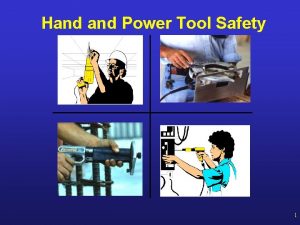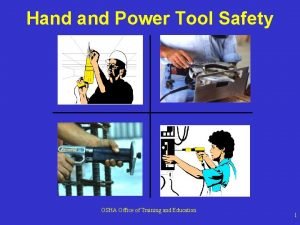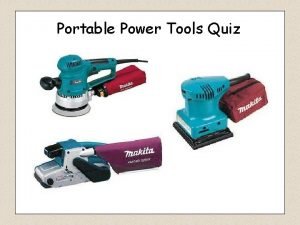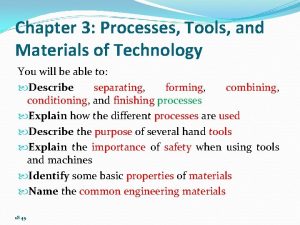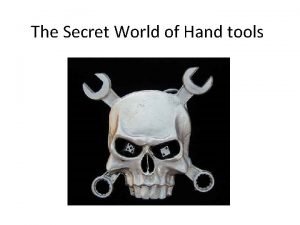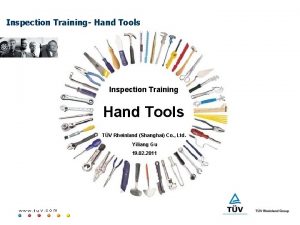Safety Talk Hand Tools Sheet 1 Hand tool








- Slides: 8

Safety Talk - Hand Tools Sheet 1 - Hand tool selection Some things to consider when choosing a hand tool are: • where the tool is to be used; • the force needed to hold or use the tool; • the direction of the force; • the weight and the construction of the tool; and • the number of repetitive actions needed. TRAINING NATIONAL

Safety Talk - Hand Tools Sheet 2 - Accidents caused by storing and carrying tools incorrectly Storing accidents: • leaving the cutting edge of knives, or saw blades, exposed in tool boxes; • chisels and other sharp tools not stored away; • heavy tools stored overhead; • round shaped tools left on the ground; and • overfull tool boxes. Carrying accidents: • screwdrivers carried in pockets; • leaving tools on vehicles during testing; • small tools falling out of pockets as you bend over; • hitting others with heavy loads when turning around; and • not telling your co-workers what you are doing. TRAINING NATIONAL

Safety Talk - Hand Tools Sheet 3 - Knives To reduce risk of injury when using a knife, you should: • always cut away from your body; • keep knives sharp; • never use knives with damaged or loose handles; • wear a protective glove on your free hand; • wear safety glasses; • wash knives separately; and • store knives in sheaths or blade protectors. TRAINING NATIONAL

Safety Talk - Hand Tools Sheet 4 - Common causes of injury from a screwdriver Damaged handles. Bent blades. Damaged or worn tips. Using the incorrect type. Holding an object in your hand while driving home a screw. Using the wrong size screwdriver for the screw being driven. Using uninsulated screwdrivers for electrical installations. TRAINING NATIONAL

Safety Talk - Hand Tools Sheet 5 - Hammers The basic rules when using a hammer are: • always wear eye protection; • strike the item or tool squarely; • ensure the hammer face is larger then the tool being struck; • select the correctly weighted hammer for the job; • never strike two hammers together; • never use a hammer with a loose or damaged handle; and • discard the hammer if the head is damaged, cracked or chipped. TRAINING NATIONAL

Safety Talk - Hand Tools Sheet 6 - Punches, chisels and drifts The basic safety rules to follow when using these tools include: • select the correct tool for the job; • hold the tool correctly; • wear eye protection; • wear hand protection; and • be aware of the sharpness and angle of the cutting edge. TRAINING NATIONAL

Safety Talk - Hand Tools Sheet 7 - Common causes of injury when using spanners The bolt or fastener coming off. The spanner slipping. The bolt breaking. The spanner breaking. The basic rules: Don’t overload the spanner by using a pipe as an extension bar. Always pull towards you. Select the correct size - don’t grind or shim the spanner to fit. Don’t hit spanners with a hammer. When using adjustable wrenches, keep the jaw towards you. TRAINING NATIONAL

Safety Talk - Hand Tools Sheet 8 - Files We can ensure the safe use of files by: • never using a file without a handle; • never hitting a file; • securing the object to be worked on in a vice or clamp. • never using a file as a lever; and • never modifying a file for other uses. TRAINING NATIONAL

